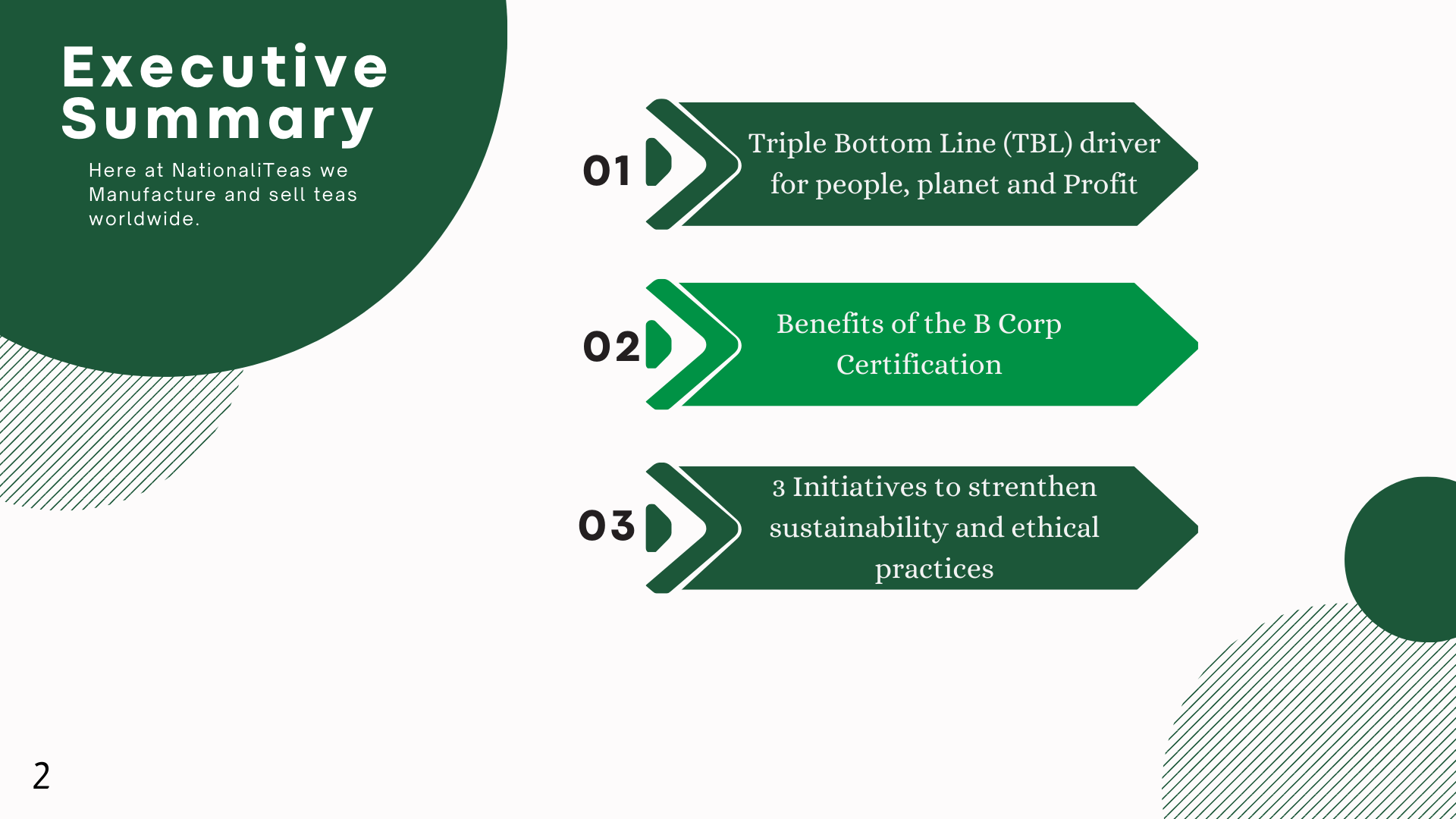Pitch Deck
This was created as a school assignment where I had to explain the importance of the Triple Bottom Line to a group of Stakeholders in a company. Underneath each slide are the talking points.

The goal of this presentation is to explain why it is important to prioritize the triple bottom line. Applying for a B Corp Certification will add value to the company and help us prioritize our focus on sustainable operational practices.

The Triple Bottom Line (TBL) has three key components: People, Planet, and Profit. People: Focuses on community, employee well-being, and supplier relationships. Prioritizing fair wages, safe working conditions, and growth opportunities creates a positive work environment with lower turnover, aligning with our mission. Planet: Emphasizes sustainability by minimizing resource use, waste, and pollution. Using renewable energy, eco-friendly shipping, and sustainable sourcing positively impacts the environment and reputation, aligning with our vision. Profit: Incorporating TBL does not sacrifice profit. Instead, it improves brand loyalty, customer retention, and long-term financial stability by streamlining processes, reducing waste, and attracting ethically-minded customers. B Corp Certification validates our ethical commitment, aligning with our mission and vision to benefit society and the environment. It will also boost employee morale and strengthen supplier and stakeholder partnerships. Three Initiatives: Establishing a TBL and Sustainability Committee Supplier Evaluation Program Renewable Energy and Eco-Friendly Shipping

People focuses on the community, employee well-being and supplier relationships. When prioritizing fair wages, safe working conditions, and opportunities for professional growth the business will have created a positive work environment with lower turnover and contribute to the society. This aligns with our mission. Planet emphasizes sustainability. This means to minimize resource consumption, waste production and pollution. By focusing on these we will positively impact the environment and improve our reputation. Using renewable energy, eco-friendly shipping, and sustainable sourcing will allow us to align with our vision. Profit. By incorporating the TBL it does not mean that we will be sacraficing our profit.

The company will benefit greatly as this will improve brand loyalty, customer retention and in turn long-term financial stability. By streamlining processes, decreasing waste will appeal to ethically responsible customers. Implementing the TBL aligns strongly with our company value and mission because this will rejuvenate the community and strengthen our brand.

The benefits of the B Corp certificate is that it validates our commitment to ethical practices. This shows customers how we are set apart from others and allow us to attract socially responsible consumers and investors.

The first iniative is creating a dedicated committee. The organizational impacts of this would be ensuring the company is staying accountable to our goals with regular monitoring. The societal impact are that the committee would foster the community initiatives, like supporting local sourcing and community development to highlight that we are a socially responsible company. The customer impact is that there would be transparency and accountability.

Initiative 2 is a comprehensive supplier evaluation. The organizational impact of this would be ensuring their quality and standards align with our values. This would improve the transparency in the supply chain. The societal impact would be that it promotes ethical responsibility by ensuring that the suppliers adhere to the ethical labor and environmental practices. This benefits the community around them. The customer impacts are that they can trust the products are ethically sourced. This enhances customer satisfaction and loyalty.

The third initiative is implementing renewable energy and eco-friendly shipping. The organizational impacts are that it will reduce the companies' carbon footprint. This would lower operational costs in the long run. The societal impact is that lower emmissions are beneficial to the environment by contributing cleaner air. The customer impacts is that they favor eco-friendly companies which means we woould appeal to more people.

The risks associated with the first initiative would be that there is an initial investment needed which will add more to the short-term budget. This can be managed by setting different targets. The second initiative risks would be that switching suppliers may have a cost increase or we may need to invest into current suppliers. This will be worked out through risk-sharing agreements ccreated with the suppliers. The third iniative risks are that it is a high initial cost to switch to renewable energy. By phasing in the renewable energy and eco shipping it would mitigate the costs to not all at once.

Implementing project management into the first initiative would allow for a structured timeline, regular reviews, and measurable outcomes. Using lean suuply chain management in the second initiative would be effective since it focuses on waste reduction and optimization. This makes it easier to integrate sustainable practices. The six sigma methods is perfect for the third initiative as it helps to streamline the processes and improve the efficiency.

The success of the first initiative will be dependent on stakeholder involvement, defined TBL metrics, and structured reporting. The change in scope may require additional resources or more time. The roles are the internal stakeholders such as the board of director, sustainability officers and the different department heads. For the second initaitve clear standards and regular audits are what define the programs successs. By applying more stringent standards this could increase the cost, but increae our value. This would be external roles such as auditors,and suppliers In initiative three phased targets are going to be beneficial for switching to more eco friendly options. Implementing nationwide renewable energy would take up a lot of time and finances. These roles would be the facility managers and energy providers.

